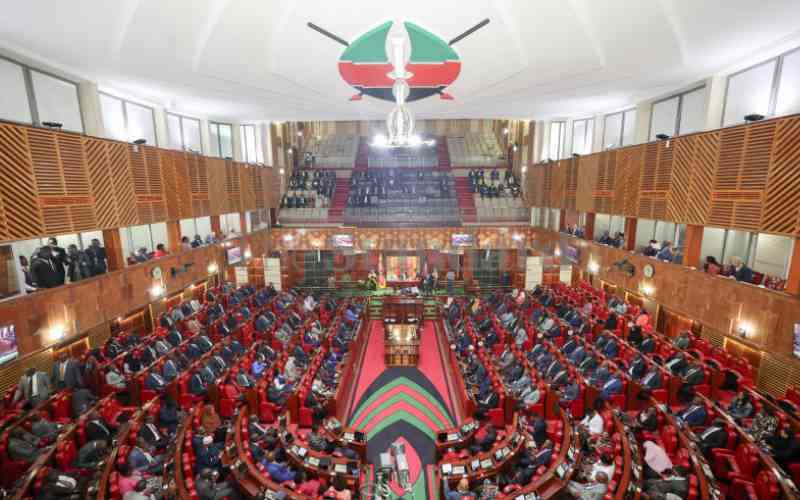With the signing of the Finance Bill 2018, it would now appear that the waters of Jordan have been separated and the hoi polloi are due to enter the Promised Land. But something is terribly a miss in this equation: Wanjiku, the supposed target beneficiary and the ultimate bearer of all the cost was forgotten back in Egypt.
Despite the sweeping implications of this proposal, as late as Friday, the top brass in the ministry driving the agenda could not candidly answer four fundamental basic questions: One, what is affordable housing in our case? Two, what is the target income bracket and are they in the formal or informal sector?
Three, what shall be the criteria for allocating the housing units? And four, what are these high yield investments where the “taxes” collected from the 3 per cent (employee and her employer) mandatory contribution be invested to guarantee the high returns after 15 years?
Facts that don’t lie
While, I am aware of the centrality of this matter under the President’s BIG 4 Agenda, I am afraid its current design and the economics behind it potent gloom at best in the medium and long term. Let’s now disaggregate the economic facts and realities.
First, what is “affordable housing” is a very subjective and complex issue. It is an economic, behavioural and a spiritual matter. Economic in the sense that it’s based on ability to pay, behavioural due to very peculiar individual taste and preferences, and spiritual due to personal contentment’s at various economic states.
Therefore, if one person lives at Karen, another at Kilimani, another in Umoja and yet another in Kibra, there is absolutely no objective measure of whether one is happier than the other under the three attributes. At minimum, each of the four is simply satisfying a basic need of shelter and eventually boils down to individual levels of satisfaction.
Flawed assumptions
Second, this agenda is premised of three key economic assumptions that are flawed, but fatal to its success. One, the housing market is historically predicated on a central planning system by an all-knowing and benevolent social planner; two, that there are arbitrage opportunities in the housing market in its current state; and three, that a political solution is the cure to a complex socio-economic, cultural and behavioural problem.
Some of the countries that have commonly been mentioned to justify the government’s intervention in the sector are Singapore and South Africa. I shall add China in my discussion. Singapore and China housing sector’s are classic case studies of a successful central all knowing social planner.
Pre-democracy apartheid South Africa was also largely centrally planned even though now it is a mixed planning. Singapore and China have comprehensive policies on general size of houses per household, ownership structure (often lease) and how a household can graduate from say, a small house unit like a one bedroom to a three-bedroom apartment, if the household requirements change.
Central planning also allows them to standardize and easily address critical amenities like sewerage, schools and hospitals, utilities and infrastructure that are extremely essential for a home ownership decision. Contrast this with the realities in Kenya. Over the past three decades, despite its phenomenal growth, the real estate sector has grown on autopilot. There was no regard to city/town master plans and public utility spaces grabbed.
More important, our government has no pre-dispositions of the sacred ideals to be a social benevolent planner whose motive, actions and decisions are solely for the benefit of the masses.
Houses for who?
In any market system, the cardinal rule of financial economic is that there can’t exist any arbitrage (profitable) opportunity in equilibrium. Therefore, if there were any profitable opportunities in the low cost housing sector, the forces of supply and demand shall have wiped them away long time ago. As per the available real estate data, all the technology necessary to develop low cost houses is in the country.
Stay informed. Subscribe to our newsletter
So, why have investors refused to go into this segment yet they are experiencing a glut in the middle and high income segments?
According to the Economic Survey 2018, the economy averaged 2.5 million and 12.7 million jobs between 2013 -2017 in formal and informal sectors respectively. The average individual real income per month was Sh30,426 and Sh32,748 for the 2013-2017 period for private and public sector respectively. If we were to factor tax and other statutory deductions, the real net take home for majority falls below Sh25,000 per month.
These facts are collaborated in the FinAccess household survey 2016. Of the 20.76 adults over 16 years old, 18.72 million earned Sh30,000 and below per month; 1.75 million earned between Sh30,001 -100,000; and only 290,300 earned over Sh100,000 per month.
The 3 per cent contributions target the 2.5 million in formal employment. But, given their real net take home, can they really afford to service a mortgage? From the scanty details available, the government is proposing to cap a bedsitter at Sh600,000 and a 3 bedroom at Sh3,000,000. The interest rate being floated around is 3-4 per cent.
According to the HFC Group (the government affiliated mortgage lender) monthly repayments for a Sh500,000 loan at 4 per cent for 15 years is Sh3,698; for a 3 million loan is Sh22,190. But can a family live in a bedsitter? Doesn’t this explain why investor’s are reluctant to go into this segment?
Why did slum upgrading collapse?
Besides, is there really any vacuum in the low cost housing segment? For starts, there is no society, community or group of people that is incapable of sum-mounding any economic challenges thrown on their path. While the policy- makers build golden mansions for themselves in exclusive neighbourhoods and investor’s gave them a wide berth, the hoi polloi regrouped among themselves in Saccos and Chamas and shilling by shilling, accumulated billions. When the winds of economic boom blew in 2003 they invested in “tu-plots” all over the country. In a nutshell, the masses the government seems to be targeting might actually be several miles ahead of it.
This push is purely political, and just like the others before, economically and technically not feasible. Just why did the Kibra and Mathare slum upgrading projects collapse?
Given, the “family home” is not only the most complex and difficult decision for those in the middle and lower income bracket, but also the most expensive. There are key lifestyle and socio-cultural considerations that defy any economic logic. For instance, the government says key in their target bracket are the young university graduates.
But we all know this digital generation of today will do anything never to be seen or associated with these perceived “low class” addresses. Aren’t the policy-maker’s not aware of the now very big “sponsorship” and “slay queens” enterprise?
Besides, majority of those lower in the pyramid may actually have no desire to own a home in the cities. Culturally, most Kenyans retire to some rural home, either their village of birth or some piece of land they bought in their working life.
Thus, while they may live in shanties in the cities, this must never be mistaken to be a home ownership need. And probably, this the biggest mistake the government is making in this equation.
Dr Muinde is an economist
 The Standard Group Plc is a
multi-media organization with investments in media platforms spanning newspaper
print operations, television, radio broadcasting, digital and online services. The
Standard Group is recognized as a leading multi-media house in Kenya with a key
influence in matters of national and international interest.
The Standard Group Plc is a
multi-media organization with investments in media platforms spanning newspaper
print operations, television, radio broadcasting, digital and online services. The
Standard Group is recognized as a leading multi-media house in Kenya with a key
influence in matters of national and international interest.
 The Standard Group Plc is a
multi-media organization with investments in media platforms spanning newspaper
print operations, television, radio broadcasting, digital and online services. The
Standard Group is recognized as a leading multi-media house in Kenya with a key
influence in matters of national and international interest.
The Standard Group Plc is a
multi-media organization with investments in media platforms spanning newspaper
print operations, television, radio broadcasting, digital and online services. The
Standard Group is recognized as a leading multi-media house in Kenya with a key
influence in matters of national and international interest.








